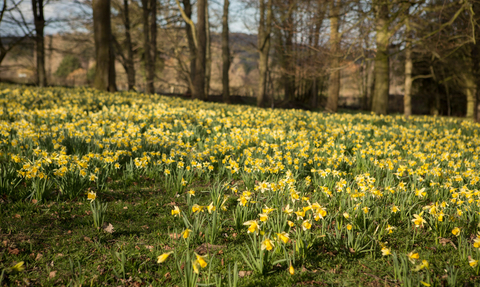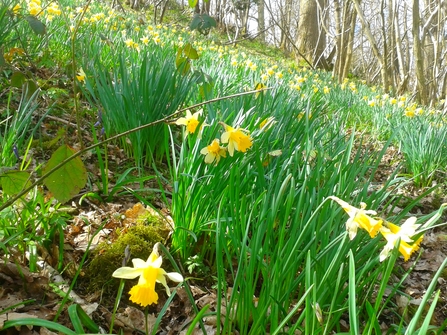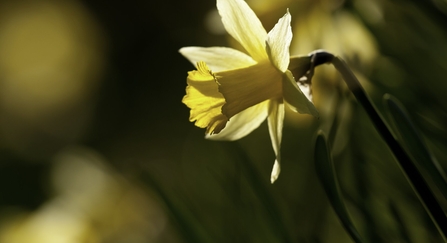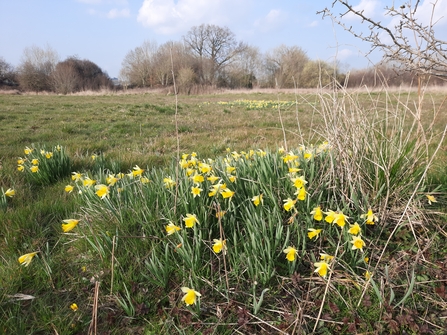
Wild daffodils (c) Paul Cooper
Where to see wild daffodils
Seeing wild daffodils on a sunny day is a real spring-time treat as these dainty pale-yellow flowers bob in the breeze. Commonly known as the ‘Lent lily’ for its long association with Easter celebrations, they come into flower towards the end of March in woodland and damp undisturbed meadows.
Once abundant, this wildflower is sadly now much rarer, having declined during the 19th century as a result of habitat loss. Here are some of the nature reserves where you can enjoy them.
Lea & Paget’s Wood
On a ridge near Fownhope, this ancient wood is one of the finest broad-leaved woodland in the Wye Valley area and the drifts of wild daffodil in April are a splendid sight. The woods have some magnificent trees dominated by sessile oak and ash and an understorey of hazel and field maple. Also look out for primrose with a chance to hear newly arrived migrant birds - the blackcap, wood warbler and chiffchaff.

Lea & Paget's wild daffodils
Hampton Park Road Meadow
Situated on the outskirts of Hereford, Hampton Park Road Meadow’s wild daffodils are at the top of the slope that looks down to the River Wye SSSI. In contrast to more showy cultivated daffodils, the wild daffodil is smaller and subtler. The petals are the colour of clotted cream, the trumpet’s a lemon hue and the narrow leaves a grey-green colour.
No parking, access on foot from Hereford’

Wild daffodil {Narcissus pseudonarcissus} (c) Ross Hoddinott/2020VISION
Sturts South
The wild daffodils in Sturts South near Letton grow well in the middle of the wet meadow where a network of wet ditches and streams connect to a number of seasonal and permanent ponds. Together with our nearby reserves at Sturts North and East, these three reserves comprise one of the largest areas of species-rich unimproved grassland in Herefordshire with a diverse range of invertebrates including water beetles, mayflies, dragonflies and damselflies inhabiting the ponds.

Wild daffodils at Sturts South
Crow Wood and Meadow
Located on the Vowchurch to Michaelchurch Escley road is Crow Wood and Meadow, home to a flourishing population of wild daffodils on the higher slopes of the ancient grassland. On the road, you pass Turnastone church with its sea of wild daffodils flowing into neighbouring fields. As spring turns to summer, there’s a succession of wildflowers on the reserve as cowslips are followed by a wonderful show of orchids

Wild daffodil {Narcissus pseudonarcissus} (c) Ross Hoddinott/2020VISION
The Golden Triangle
For prolific blooms of wild daffodil a visit to the ‘Golden Triangle’ around Dymock on the Gloucestershire and Herefordshire borders is a must. Each year the villages of Dymock, Kempley and Oxenhall organise a festival including guided walks to see the flowers with teas in Dymock.
Veil Mill Meadow, near Dymock is one of the best surviving wild daffodil meadows. This nature reserve owned by Gloucestershire Wildlife Trust forms part of the area where, in the past, thousands of people would visit during the spring - traveling up from London on the train to pick the flowers to take back and sell.
There are also many well established patches of wild daffodil across the county, in the woods nearby to Breinton Spring, Wessington Pasture in the Woolhope Dome and on the top of May Hill in Gloucestershire near Ross-on-Wye.

Wild daffodils in the Golden Triangle
